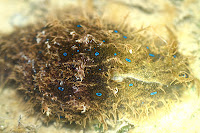Today, I had to drag myself out of bed (having managed to sleep for just an hour) at 2am and brave the long lonely drive to Changi for what was possibly the last early morning trip for the year. Although Changi Beach Park is reclaimed, it is still rich in biodiversity, particularly since the area has lush meadows of fern seagrass (Halophila spinulosa).
Upon arrival, we wasted no time at all as the tides was not going to stay low for a very long time. One of the first things I saw were the thorny sea cucumbers I used to see when I was a child. These small colourful sea cucumbers are commonly found in our northern shores, often found in seagrass areas or clinging to rocks, dead corals and even trash like discarded glass bottles. When feeding, these sea cucumbers display feeding tentacles which are usually in hues of yellow and red. It should be distinguished from a similar looking sea cucumber known as the pink warty sea cucumber (Cercodemas anceps) which is pink and yellow and also found in our northern shores.



One of the other more unusual finds were these fairly large hairy sea hares (Bursatella leachii) . This particular species of sea slug is usually found in our northern shores (usually in silty, sandy areas near seagrasses and seaweeds) and appear seasonally. Sea Hares lack external shells and when out of water, they usually look like a jelly blob. Apparently they grow fairly large, sometimes reaching 60cm long and weighing 5kg.



I did also get to see a juvenile tripod fish, a large shoal of baby striped eeltail catfish, a pink sand dollar (Peronella lesueuri), a small lime-green starfish (which Mei Lin thinks is a baby knobbly).
It's truly amazing to know that our shores are still rich in biodiversity despite all of man's activities. Perhaps the only regret I have is the effects of land reclamation and how this has contributed to the amount of loose sediment in the area. One has to step gingerly into the water in order to get close enough to a subject.









*All images taken with Canon 7D and Canon EF 100mm f/2.8 L IS USM Macro lens, Canon 580 EX II Speedlite, Canon Powershot G10*
HI. MAY I KNOW WHICH PART OF CHANGI SHORE YOU ARE REFERRING TO?
ReplyDelete